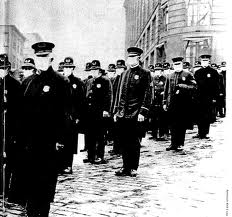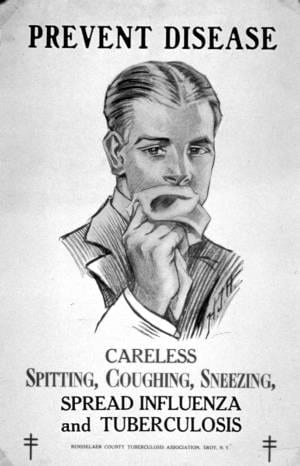Viruses of Mice and Men
By Gemma Angel, on 3 June 2013
 by Sarah Savage
by Sarah Savage
Recently in the Grant Museum, I had the most exciting 35 minute engagement with a mother and son visiting London from Jersey in the Channel Islands. Since her son was very interested in coming to UCL for undergraduate study, the mum thought the best idea would be to visit the campus and see all that UCL has to offer, including the museums on campus. I caught this family on their first stop on the UCL museums trail. After introducing myself and telling the boy’s mother a little bit about the UCL student engagers group, she quickly asked what my research is specifically about. I told her that I am an historical epidemiologist specializing in the Spanish Influenza Pandemic 1918-19, and the Encephalitis Lethargica Epidemic 1917-1930. Her eyes grew quite wide and she replied that her son had been hoping to meet someone doing research like mine, to find out more about pandemics. Her main reference point for Spanish Influenza was that the character Edward Cullen from the Twilight films had died from the pandemic! Alas, I encounter that response quite often. If anything, Twilight put the ‘forgotten pandemic’ on the radar of the general population and teenage girls everywhere.[1]
 Although previously I’ve mainly engaged in the Petrie Museum next to objects of everyday Egyptian life that relate to disease, I found that amongst the great preserved animals of medical colleges past, many fascinating connections to my research topic presented themselves in conversation with visitors. The display of parasitic worms, although admittedly horrifying, can be used as a tool to demonstrate how a virus inhabits and travels through the body. A gentleman visitor later in the afternoon stood in shock when confronted with the incredible size of some of the parasitic worms that are able to live in the human body.
Although previously I’ve mainly engaged in the Petrie Museum next to objects of everyday Egyptian life that relate to disease, I found that amongst the great preserved animals of medical colleges past, many fascinating connections to my research topic presented themselves in conversation with visitors. The display of parasitic worms, although admittedly horrifying, can be used as a tool to demonstrate how a virus inhabits and travels through the body. A gentleman visitor later in the afternoon stood in shock when confronted with the incredible size of some of the parasitic worms that are able to live in the human body.
The brave visitor from Jersey further engaged with me to discuss exactly how viruses spread through the body, mutate, and ‘disappear’ after an outbreak. I put disappear in parenthesis, since some viruses can simply become dormant in the body. During our conversation, she inquired as to what initially drew me to epidemics. “Most young students do not dream of studying viruses that wipe out entire populations for a living!” she told me.  Oh, but I was that student, fascinated by the plague, and how tiny organisms could exist in our bodies. Once I’d told her more about my academic background in the United States, she asked me how common it is for historians to examine medicine or epidemics. Although UCL previously had a Centre for the History of Medicine for postgraduate researchers, now we are divided amongst different disciplines including history, neurology, and psychology. As an historian specialising in epidemics, I explained to her that I am not only interested in the physical side of how epidemics work, but also how societies react to an outbreak. During the 1918-19 Spanish Influenza outbreak, governments in England and the United States quarantined areas of cities and closed all government buildings. Although these measures prevented the spread of the virus to some extent, many citizens became infected prior to the required quarantines and closures. There are many links between government measures and public behaviour during historical influenza epidemics during the early 20th century and the avian and swine flu outbreaks of present day.The visitor mentioned the 2009 Swine Flu outbreak, and how the fear of coming into contact with an infected person effected daily life and decisions to frequent public spaces. By the end of our lengthy conversation, we had discussed everything from 20th century epidemics to life on the Channel Islands and life as a UCL student. After her son had finished peering into every case in the Grant Museum, his mother expressed how enlightened and intellectually stimulated she felt to discuss such a specialised topic with a UCL researcher, before moving on to encounter another member of our team at one of UCL other museum spaces. As a new team member, this was a heartening conclusion to a very inspiring conversation, and I am thoroughly looking forward to future conversations with museums visitors from all over the world…
Oh, but I was that student, fascinated by the plague, and how tiny organisms could exist in our bodies. Once I’d told her more about my academic background in the United States, she asked me how common it is for historians to examine medicine or epidemics. Although UCL previously had a Centre for the History of Medicine for postgraduate researchers, now we are divided amongst different disciplines including history, neurology, and psychology. As an historian specialising in epidemics, I explained to her that I am not only interested in the physical side of how epidemics work, but also how societies react to an outbreak. During the 1918-19 Spanish Influenza outbreak, governments in England and the United States quarantined areas of cities and closed all government buildings. Although these measures prevented the spread of the virus to some extent, many citizens became infected prior to the required quarantines and closures. There are many links between government measures and public behaviour during historical influenza epidemics during the early 20th century and the avian and swine flu outbreaks of present day.The visitor mentioned the 2009 Swine Flu outbreak, and how the fear of coming into contact with an infected person effected daily life and decisions to frequent public spaces. By the end of our lengthy conversation, we had discussed everything from 20th century epidemics to life on the Channel Islands and life as a UCL student. After her son had finished peering into every case in the Grant Museum, his mother expressed how enlightened and intellectually stimulated she felt to discuss such a specialised topic with a UCL researcher, before moving on to encounter another member of our team at one of UCL other museum spaces. As a new team member, this was a heartening conclusion to a very inspiring conversation, and I am thoroughly looking forward to future conversations with museums visitors from all over the world…
References
[1] Alfred W. Crosby: America’s Forgotten Pandemic: The Influenza of 1918, Cambridge: Cambridge University Press, (2003).
 Close
Close

